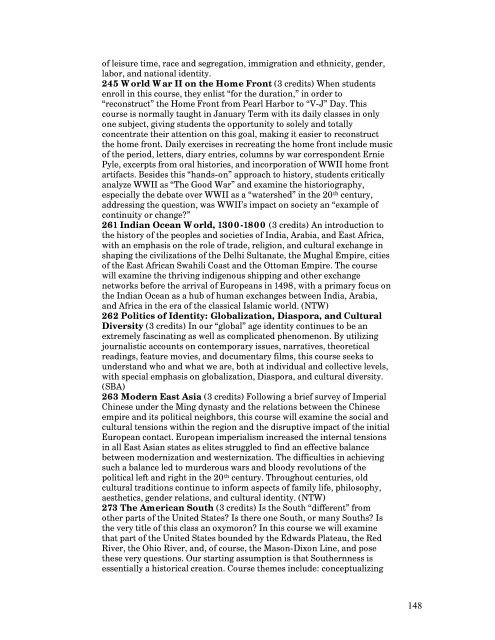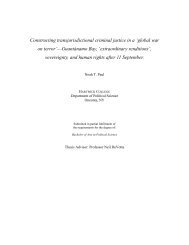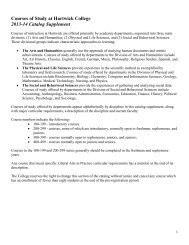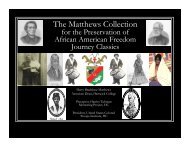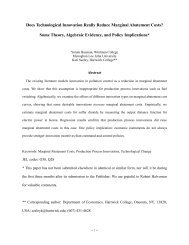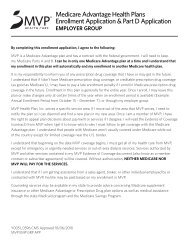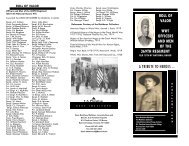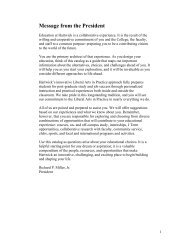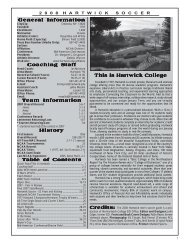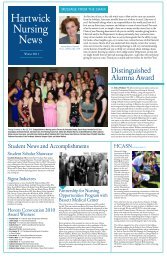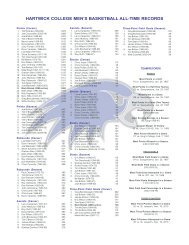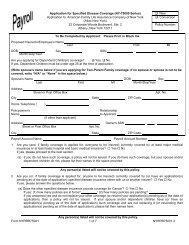Table of Contents - Hartwick College
Table of Contents - Hartwick College
Table of Contents - Hartwick College
You also want an ePaper? Increase the reach of your titles
YUMPU automatically turns print PDFs into web optimized ePapers that Google loves.
<strong>of</strong> leisure time, race and segregation, immigration and ethnicity, gender,<br />
labor, and national identity.<br />
245 World War II on the Home Front (3 credits) When students<br />
enroll in this course, they enlist “for the duration,” in order to<br />
“reconstruct” the Home Front from Pearl Harbor to “V-J” Day. This<br />
course is normally taught in January Term with its daily classes in only<br />
one subject, giving students the opportunity to solely and totally<br />
concentrate their attention on this goal, making it easier to reconstruct<br />
the home front. Daily exercises in recreating the home front include music<br />
<strong>of</strong> the period, letters, diary entries, columns by war correspondent Ernie<br />
Pyle, excerpts from oral histories, and incorporation <strong>of</strong> WWII home front<br />
artifacts. Besides this “hands-on” approach to history, students critically<br />
analyze WWII as “The Good War” and examine the historiography,<br />
especially the debate over WWII as a “watershed” in the 20 th century,<br />
addressing the question, was WWII’s impact on society an “example <strong>of</strong><br />
continuity or change?”<br />
261 Indian Ocean World, 1300-1800 (3 credits) An introduction to<br />
the history <strong>of</strong> the peoples and societies <strong>of</strong> India, Arabia, and East Africa,<br />
with an emphasis on the role <strong>of</strong> trade, religion, and cultural exchange in<br />
shaping the civilizations <strong>of</strong> the Delhi Sultanate, the Mughal Empire, cities<br />
<strong>of</strong> the East African Swahili Coast and the Ottoman Empire. The course<br />
will examine the thriving indigenous shipping and other exchange<br />
networks before the arrival <strong>of</strong> Europeans in 1498, with a primary focus on<br />
the Indian Ocean as a hub <strong>of</strong> human exchanges between India, Arabia,<br />
and Africa in the era <strong>of</strong> the classical Islamic world. (NTW)<br />
262 Politics <strong>of</strong> Identity: Globalization, Diaspora, and Cultural<br />
Diversity (3 credits) In our “global” age identity continues to be an<br />
extremely fascinating as well as complicated phenomenon. By utilizing<br />
journalistic accounts on contemporary issues, narratives, theoretical<br />
readings, feature movies, and documentary films, this course seeks to<br />
understand who and what we are, both at individual and collective levels,<br />
with special emphasis on globalization, Diaspora, and cultural diversity.<br />
(SBA)<br />
263 Modern East Asia (3 credits) Following a brief survey <strong>of</strong> Imperial<br />
Chinese under the Ming dynasty and the relations between the Chinese<br />
empire and its political neighbors, this course will examine the social and<br />
cultural tensions within the region and the disruptive impact <strong>of</strong> the initial<br />
European contact. European imperialism increased the internal tensions<br />
in all East Asian states as elites struggled to find an effective balance<br />
between modernization and westernization. The difficulties in achieving<br />
such a balance led to murderous wars and bloody revolutions <strong>of</strong> the<br />
political left and right in the 20 th century. Throughout centuries, old<br />
cultural traditions continue to inform aspects <strong>of</strong> family life, philosophy,<br />
aesthetics, gender relations, and cultural identity. (NTW)<br />
273 The American South (3 credits) Is the South “different” from<br />
other parts <strong>of</strong> the United States? Is there one South, or many Souths? Is<br />
the very title <strong>of</strong> this class an oxymoron? In this course we will examine<br />
that part <strong>of</strong> the United States bounded by the Edwards Plateau, the Red<br />
River, the Ohio River, and, <strong>of</strong> course, the Mason-Dixon Line, and pose<br />
these very questions. Our starting assumption is that Southernness is<br />
essentially a historical creation. Course themes include: conceptualizing<br />
148


